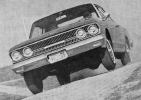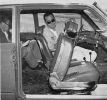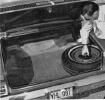
| 
|
|---|---|
| New styling is based on lean, clean lines that are apparent from almost any angle. Cars weigh 150 pounds less this year. | Big feature for '63 is the Twin-Stick overdrive unit. It's simpler and more convenient, has short throws. |


 1963 Rambler
1963 Rambler
Motor Trend / February 1963
For our tests we chose a Classic Six, Series 660, four-door sedan and an Ambassador V-8, Series 990, two-door club sedan. The Classic Six is strictly an economy family sedan, while the Ambassador V-8 is a sportier, more performance-oriented vehicle. This, we felt, gave us a good cross-section of what's available in the way of models, engines, and drive trains.
Our Classic was equipped with the rugged, ohv in-line Six engine -- a long-stroke, 195.6-cubic-inch unit that produces 127 hp at 4200 rpm. This was coupled with the optional E-Stick transmission and 3.78-to-1 rear axle. No power equipment was installed, in keeping with the car's economy appeal.

| 
|
|---|---|
| New styling is based on lean, clean lines that are apparent from almost any angle. Cars weigh 150 pounds less this year. | Big feature for '63 is the Twin-Stick overdrive unit. It's simpler and more convenient, has short throws. |
The Ambassador was loaded with options, including power steering, power brakes, and the big 327-cubic-inch V-8. The power-pack option, which consists of 9.7-to-1 compression ratio (8.7 is standard) and a four-barrel carburetor, gives this engine 270 hp at 4700 rpm (250 hp standard). The newly introduced and optional Twin-Stick overdrive transmission was installed and driven through a 3.54-to-1, Twin-Grip rear axle.
Both the Classic and Ambassador share the new 112-inch wheelbase body/chassis unit and are identical in exterior and interior dimensions. Although this represents an increase in length of four inches in wheelbase over previous models, the overall length of the new Ramblers is more than an inch shorter. This means that a lot of excess overhang has been chopped off, and has resulted in a cleaner, more functional design. The lengthened wheelbase has given more room inside the cars, and this means increased driver/passenger comfort.
The major difference between the Classic and Ambassador (other than trim) is powerplants. The Classic is available only with the Six, while the Ambassador offers only the V-8.
Performance of the Classic is about average for a car of this type -- adequate but nothing more. It can pull 68 mph at the end of the quarter-mile, taking an average of 21.5 seconds to do so. The 0-30, 0-45, and 0-60 increments took 5.3, 10.2, and 15.9 seconds respectively. With the standard three-speed manual transmission, these times would improve slightly because the E-Stick gets away rather slowly in low.
For those not familiar with the E-Stick, it's basically a standard three-speed manual hooked to an automatic clutch. No clutch pedal is used, and clutching is done automatically. Shifting is the same as with any three-speed manual. This is designed primarily for the man who lies to shift gears but has a wife who can only manage an automatic. The E-Stick will suit both drivers at a price much lower than they'd pay for an automatic transmission. The E-Stick isn't available on Ambassador models. Other classic options include conventional-clutch three-speed, Twin-Stick overdrive, automatic, and E-Stick with overdrive.
Optionally available for the Classic is a two-barrel carburetor that boosts horsepower to 138 at 4500 rpm. This engine was in the Rambler American test car.
The Ambassador should satisfy the wants of the Rambler buyer who favors performance over economy. Our test car ran the 0-30, 0-45, and 0-60 stages in 3.0, 6.0, and 9.6 seconds, with the quarter-mile covered in 17.8 seconds and 82 mph. Considering the 3.54 rear axle, these times were very good. With th optional 4.10 gearset they'd be even better.
The new Twin-Stick overdrive transmission offers several advantages over a conventional setup. The console-mounted control levers fall more readily to the hand and more positive shifts are possible, due to the well designed shift linkage. Throws between gears are short, and there's absolutely no slop in the linkage. The in/out lever for overdrive is easier to manage than the usual dash-mounted handle, and instead of the kick-down switch being actuated by the throttle, it's mounted on top of the gearshift lever and is hand controlled. This means the throttle doesn't have to be wide open before the unit will shift down out of overdrive -- which should be easier on drive train components. Also available are the standard three-speed manual and optional three-speed automatic transmissions.

| 
|
|---|---|
| Dashboard layout is identical on both the Classic and Ambassador models. Compact arrangement is easy to read, and all controls are in driver's reach. | Despite differences in weight between six- and eight-cylinder models, both are equally light-feeling and completely responsive to all road conditions. |
There won't be many cars of this size delivering more fuel economy than the basic-engined Classic. A thousand miles of highway and city driving gave an overall average of 23.1 mpg. One tank of only highway cruising gave a high os 26.7 mph, and this was at legal speeds (60 to 65 mph). City traffic dropped mileage down to 20.4 mph, while mixed city and freeway gave 23.4. The thermostat in the test car stuck closed early in the test and was removed. So quite a bit of the mileage was logged without it, and consequently the engine was running colder than normal. If the engine had been running at the proper temperature, it's possible that it would've delivered even better mileage figures.
The Ambassador V-8 gave good mileage when it wasn't driven flat out from every stop sign and when the secondary throttles on the four-barrel carburetor weren't brought into action too often. We logged close to a thousand miles in the test car and came up with an overall average of 16.3 mpg. This included an open-road high of 19.4 mpg and an around-town low of 13.7 mpg. Mixed road and city driving produced 16.0 mpg. Without the power-pack, this engine would burn regular-grade gasoline and at a slightly lower rate, probably in the 16- to 22-mpg range. None of the other drive train options will deliver better mileage than the manual/overdrive combination. Cruising along at 65 mph in overdrive, the engine's barely turning 2000 rpm, as against almost 2500 rpm in conventional. This means that at a given speed the engine is doing the same work with 25 per cent less effort in overdrive.

| 
|
|---|---|
| Curved side windows are said to cancel excessive wind noises. Note that window frames are made of aluminum extrusions. | Rambler suspension is by coils all around, but they're firm enough so that rough roads can be stormed with confidence. |
Both cars were capable of repeated straight-line stops with a minimum of brake fade. Because of the added weight of the big V-8, the Ambassador has more effective brake lining area and this, coupled with the power brakes, accounted for the shorter stopping distances the Ambassador recorded. All Ramblers offer the tandem master cylinder as standard equipment. This is, in effect, two separate braking systems for the front and rear wheels and means that if either system should suddenly fail, the remaining one can bring the car to a safe stop.
In spite of almost 400-pounds difference in curb weights between the Classic and Ambassador (with most of the difference on the Ambassador's front end), the two cars handle almost identically. an anti-roll bar at the front enables the Ambassador to corner with less lean than the Classic, but both feel pleasingly light and responsive under all cornering conditions. Both are basic understeerers, but even on hard, tight corners the driver never consciously feels the front ends pushing excessively. At high cruising speeds the Ambassador is the more stable car and is little affected by cross-winds. But while the Classic will tend to wander slightly in high winds, it isn't to an objectionable degree.

| 
|
|---|---|
| Interior offers plenty of leg room. Reclining bucket seats with headrests are options well worth the extra expenditure. | Trunk is large, with good amount of usable space. Low loading lip makes it a simple matter to load or unload big things. |
Both cars have a good boulevard and highway ride. There isn't any pitch or choppiness noticeable even on rough roads.
Quality has always been one of American Motors' largest selling points and continues to be on the new models. Our test cars were among the first off the assembly line, but there were none of the usual bugs you come to expect in completely new, first-run models. All panels, doors, and trim were precision fit, and we didn't notice any annoying rattles on even the roughest roads.
In the field of unitized bodies, which American Motors (then Nash-Kelvinator) pioneered, this latest design represents a real advancement and the biggest single reason we chose Rambler Car of the Year. Not only does this new construction method save approximately 150 pounds over the older deign, but it results in a unit so strong it'll take punishment longer and naturally hold its resale value. all this adds up to greater customer appreciation, in which, incidentally, Rambler has never been lacking.

| 
|
|---|---|
| Tandem master cylinder is standard on all Ramblers, while alternator is standard only on V-8s and air-conditioned Sixes. | Rugged, dependable in-line Six with Holley carb has proved its miserliness by winning economy runs and performance trials. |
The interiors of both the Classic and Ambassador are roomy and comfortable. The four-door Classic had the optional slipt-back, reclining front seat -- while the Ambassador had reclining, individual bucket seats. These reclining seats come in handy for the front seat passenger, but we have yet to find a reason for the driver to use them (other than for sleeping, should the occasion arise). If they were infinitely variable in their operation, you could theoretically find just the right angle for optimum driving comfort, but they have only several fixed positions and none of them can be used while driving the car.
The instrument panel carries a large speedometer, flanked on either side by the water temperature and fuel level gauges, plus the various headlight, wiper, and temperature control knobs. Warning lights are used for oil pressure and alternator. Clear-weather visibility is excellent, and foul-weather visibility is improved by the adoption of parallel-action windshield wipers, which eliminate the usual center blind spot.
In addition to the long-recognized owner appreciation feature inherent in all Ramblers, the factory has doubled the new-car warranty to 24 months or 24,000 miles. In summing up, all we can add is that it looks like the new Rambler will be an even better buy than it has been in previous years.